Optimization of Greenhouse Thermal Screens for Maximized Energy Conservation
Abstract
:1. Introduction
2. Materials and Methods
2.1. Experimental Greenhouse
2.2. Thermal Conductivity Measurement
2.3. BES Modeling
2.3.1. Pre-processing
2.3.2. Modeling
2.3.3. Simulation
2.4. Validation
2.5. Statistical Analysis of BES Model
2.6. Sensitivity Analysis
3. Results and Discussion
4. Conclusions
Author Contributions
Funding
Conflicts of Interest
References
- Rasheed, A.; Lee, J.W.; Lee, H.W. Evaluation of overall heat transfer coefficient of different greenhouse thermal screens using building energy simulation. Prot. Hortic. Plant Fact. 2018, 27, 294–301. [Google Scholar] [CrossRef]
- Ghosal, M.K.; Tiwari, G.N. Mathematical modeling for greenhouse heating by using thermal curtain and geothermal energy. Sol. Energy 2004, 76, 603–613. [Google Scholar] [CrossRef]
- Rasheed, A.; Lee, J.W.; Lee, H.W. Development of a model to calculate the overall heat transfer coefficient of greenhouse covers. Span. J. Agric. Res. 2017, 15, 1–11. [Google Scholar] [CrossRef]
- Kassai, M. Experimental investigation of carbon dioxide cross-contamination in sorption energy recovery wheel in ventilation system. Build. Serv. Eng. Res. Technol. 2018, 39, 463–474. [Google Scholar] [CrossRef]
- Kassai, M.; Simonson, C.J. Performance investigation of liquid-to-air membrane energy exchanger under low solution/air heat capacity rates ratio conditions. Build. Serv. Eng. Res. Technol. 2014, 36, 535–545. [Google Scholar] [CrossRef]
- Kassai, M.; Al-Hyari, L. Investigation of ventilation energy recovery with polymer membrane material-based counter-flow energy exchanger for nearly zero-energy buildings. Energies 2019, 12, 1727. [Google Scholar] [CrossRef]
- Hemming, S.; Romero, E.B.; Mohammadkhani, V.; van Breugel, B. Energy Saving Screen Materials: Measurement Method of Radiation Exchange, Air Permeability and Humidity Transport and a Calculation Method for Energy Saving; Wageningen University & Research, BU Greenhouse Horticulture: Bleiswijk, The Netherlands, 2017. [Google Scholar]
- Shukla, A.; Tiwari, G.N.; Sodha, M.S. Thermal modeling for greenhouse heating by using thermal curtain and an earth–air heat exchanger. Build. Environ. 2006, 41, 843–850. [Google Scholar] [CrossRef]
- Shakir, S.M.; Farhan, A.A. Movable thermal screen for saving energy inside the greenhouse. Assoc. Arab Univ. J. Eng. Sci. 2019, 26, 106–112. [Google Scholar] [CrossRef]
- Kittas, C.; Katsoulas, N.; Baille, A. Influence of an aluminized thermal screen on greenhouse microclimate and canopy energy balance. Trans. ASAE 2003, 46, 1653–1663. [Google Scholar] [CrossRef]
- Teitel, M.; Barak, M.; Antler, A. Effect of cyclic heating and a thermal screen on the nocturnal heat loss and microclimate of a greenhouse. Biosyst. Eng. 2009, 102, 162–170. [Google Scholar] [CrossRef]
- Park, B.S.; Kang, T.H.; Han, C.S. Analysis of heating characteristics using aluminum multi-layer curtain for protected horticulture greenhouses. J. Biosyst. Eng. 2015, 40, 193–200. [Google Scholar] [CrossRef]
- Taki, M.; Ajabshirchi, Y.; Ranjbar, S.F.; Rohani, A.; Matloobi, M. Modeling and experimental validation of heat transfer and energy consumption in an innovative greenhouse structure. Inf. Process. Agric. 2016, 3, 157–174. [Google Scholar] [CrossRef] [Green Version]
- Kim, H.-K.; Kang, G.-C.; Moon, J.-P.; Lee, T.-S.; Oh, S.-S.J.E. Estimation of thermal performance and heat loss in plastic greenhouses with and without thermal curtains. Energies 2018, 11, 578. [Google Scholar] [CrossRef]
- Diop, S.; Lee, J.W.; Na, W.H.; Lee, H.W. Overall heat transfer coefficient measurement of covering materials with thermal screens for greenhouse using the hot box method. J. Korean Soc. Agric. Eng. 2012, 54, 1–7. [Google Scholar]
- Diop, S.; Lee, J.W.; Lee, H.W. Measurement and comparison of overall heat transfer coefficients for greenhouse covering materials with thermal screens. J. Korean Soc. Agric. Eng. 2014, 56, 41–51. [Google Scholar]
- Lee, J.W.; Kim, D.K.; Lee, H.W. A numerical study for calculation of overall heat transfer coefficient of double layers covering and insulation material for greenhouse. Curr. Res. Agric. Life Sci. 2015, 33, 41–47. [Google Scholar]
- Rasheed, A.; Lee, J.; Lee, H. Development and optimization of a building energy simulation model to study the effect of greenhouse design parameters. Energies 2018, 11, 2001. [Google Scholar] [CrossRef]
- Chargui, R.; Sammouda, H.; Farhat, A. Geothermal heat pump in heating mode: Modeling and simulation on trnsys. Int. J. Refrig. 2012, 35, 1824–1832. [Google Scholar] [CrossRef]
- Klein, S.A. Trnsys, a Transient System Simulation Program; Solar Energy Laborataory, University of Wisconsin-Madison: Madison, WI, USA, 2012. [Google Scholar]
- Carlini, M.; Monarca, D.; Biondi, P.; Honorati, T.; Castellucci, S. A simulation model for the exploitation of geothermal energy for a greenhouse in the viterbo province. In Work Safety and Risk Prevention in Agro-Food and Forest Systems, Proceedings of the International Conference Ragusa SHWA, Ragusa, Italy, 16–18 September 2010; SHWA: Ragusa, Italy, 2010; pp. 16–18. [Google Scholar]
- Rasheed, A.; Lee, J.W.; Lee, H.W. A review of greenhouse energy management by using building energy simulation. Prot. Hortic. Plant Fact. 2015, 24, 317–325. [Google Scholar] [CrossRef]
- Rafiq, A.; Na, W.H.; Rasheed, A.; Lee, J.W.; Lee, H.W. Measurement of long-wave radiometric properties of shading nets and thermal screens. Pak. J. Agric. Sci. 2019. (In process) [Google Scholar]
- Valera, M.D.; Molina, A.F.; Alvarez, M.A. Protocolo de Auditoría Energética en Invernaderos. Auditoría Energética de un Invernadero para Cultivo de Flor Cortada en Mendigorría; Instituto para la diversificacion y ahorro de la energia: Madrid, Spain, 2008. [Google Scholar]
- Lam, J.C.; Hui, S.C.M. Sensitivity analysis of energy performance of office buildings. Build. Environ. 1996, 31, 27–39. [Google Scholar] [CrossRef]
- Yang, S.-H.; Son, J.-E.; Lee, S.-D.; Cho, S.-I.; Araghi, A.A.; Rhee, J.-Y. Surplus thermal energy model of greenhouses and coefficient analysis for effective utilization. Span. J. Agric. Res. 2016, 14, 4. [Google Scholar] [CrossRef] [Green Version]
- Shukla, A.; Tiwari, G.; Sodha, M. Energy conservation potential of inner thermal curtain in an even span greenhouse. Trends Appl. Sci. Res. 2006, 1, 542–552. [Google Scholar]
- Ahamed, M.S.; Guo, H.; Tanino, K. Sensitivity analysis of csgheat model for estimation of heating consumption in a chinese-style solar greenhouse. Comput. Electron. Agric. 2018, 154, 99–111. [Google Scholar] [CrossRef]
- Seginer, I.; Albright, L.D. Rational operation of greenhouse thermal-curtains. Trans. ASAE 1980, 23, 1240–1245. [Google Scholar] [CrossRef]
- Bailey, B.J. Control strategies to enhance the performance of greenhouse thermal screens. J. Agric. Eng. Res. 1988, 40, 187–198. [Google Scholar] [CrossRef]



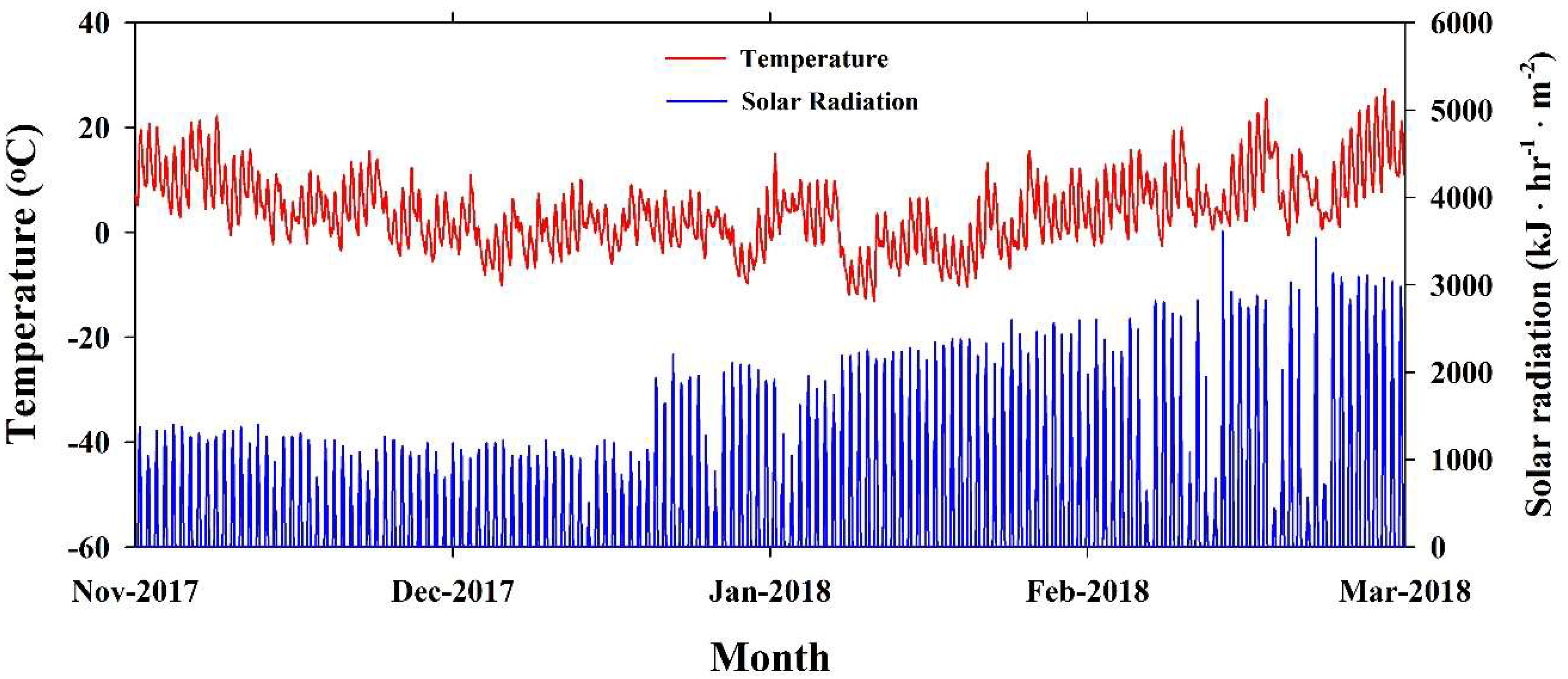


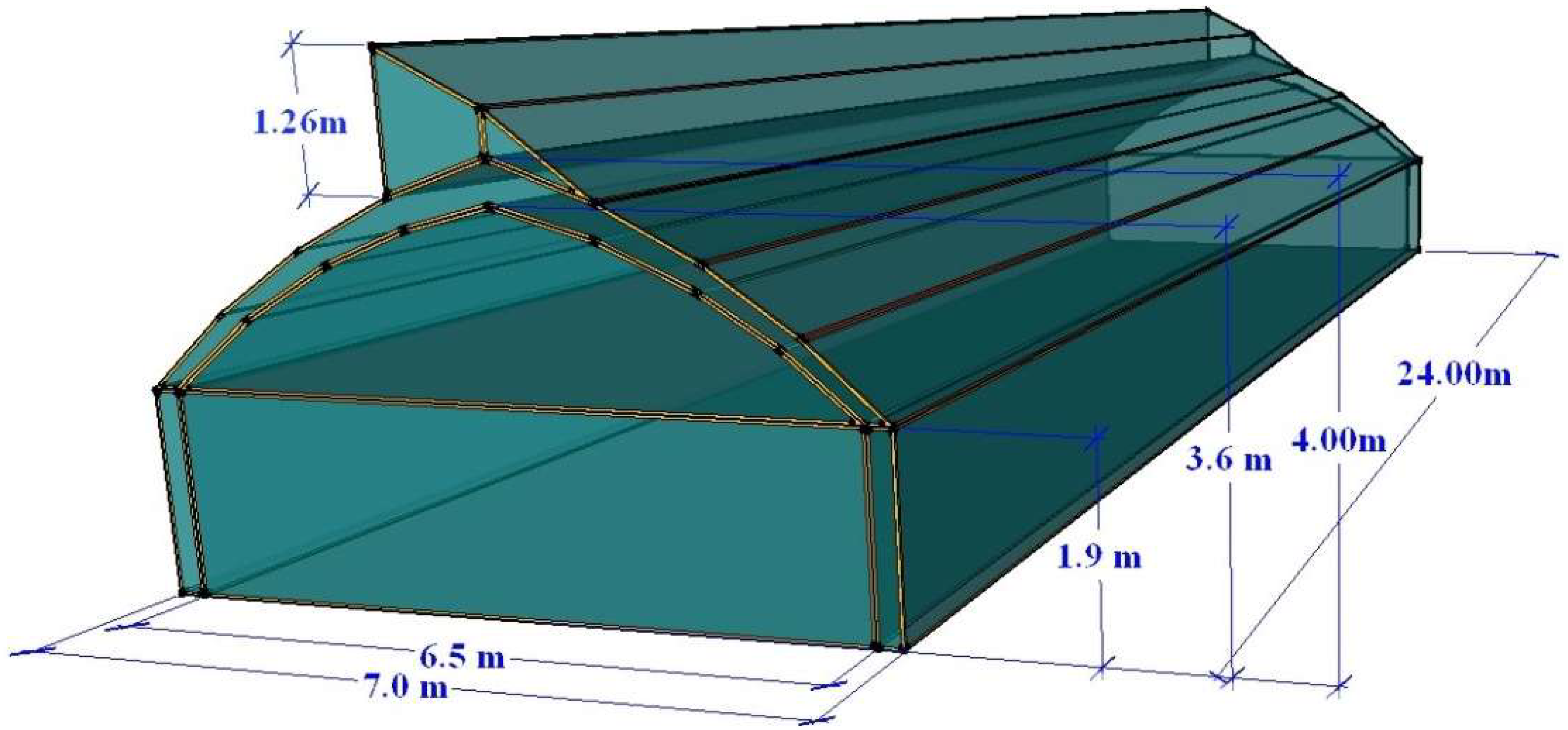
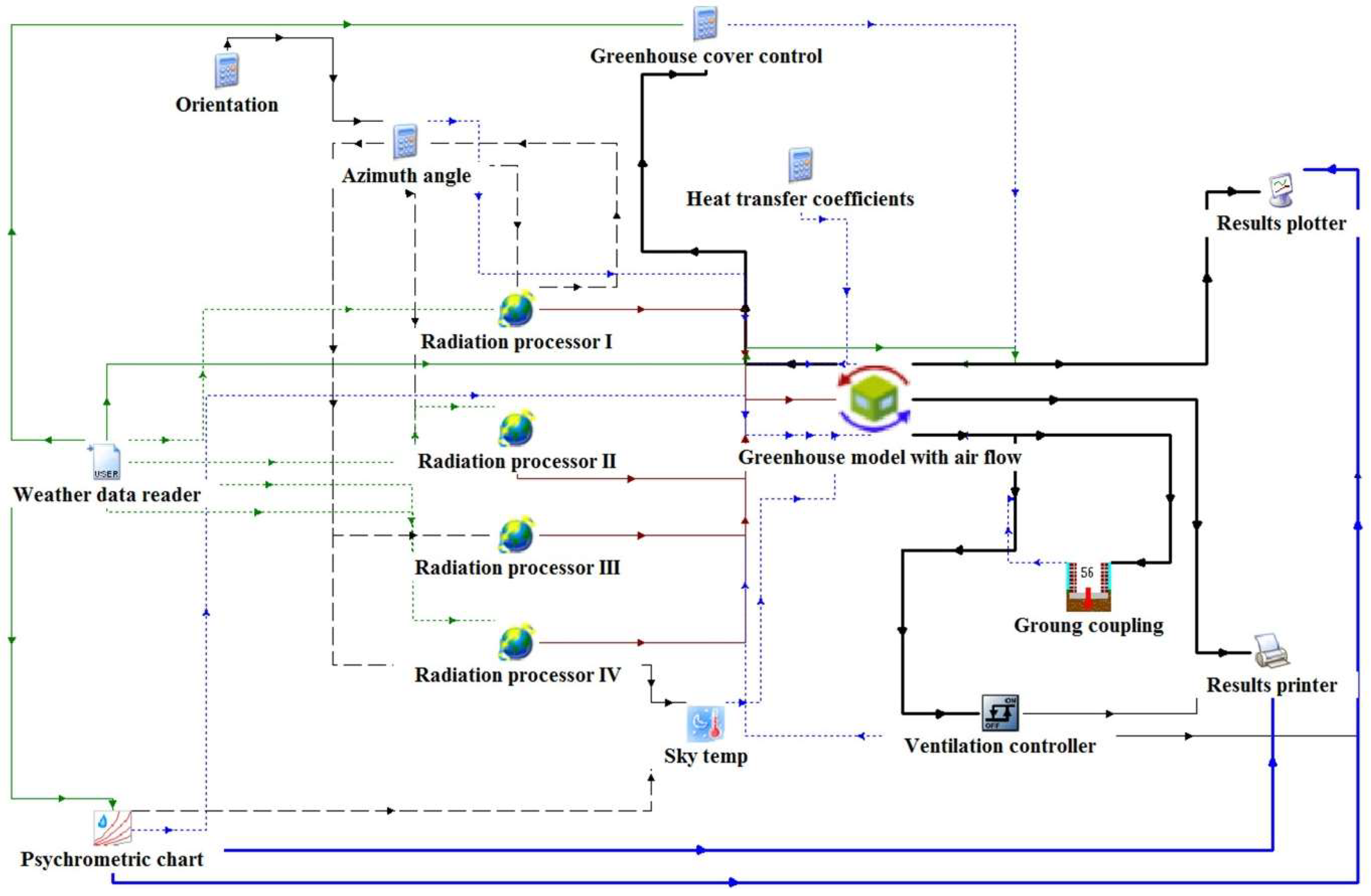
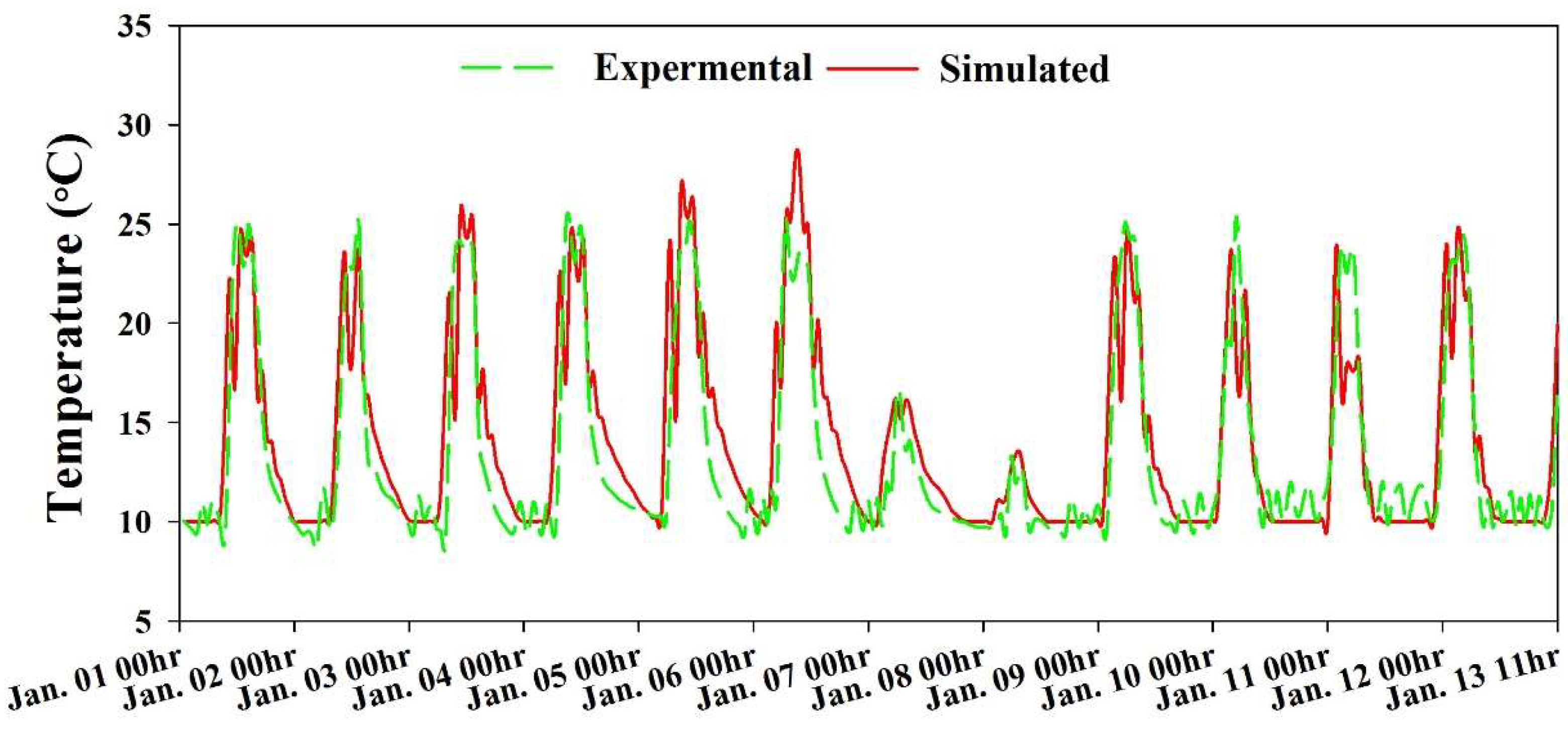

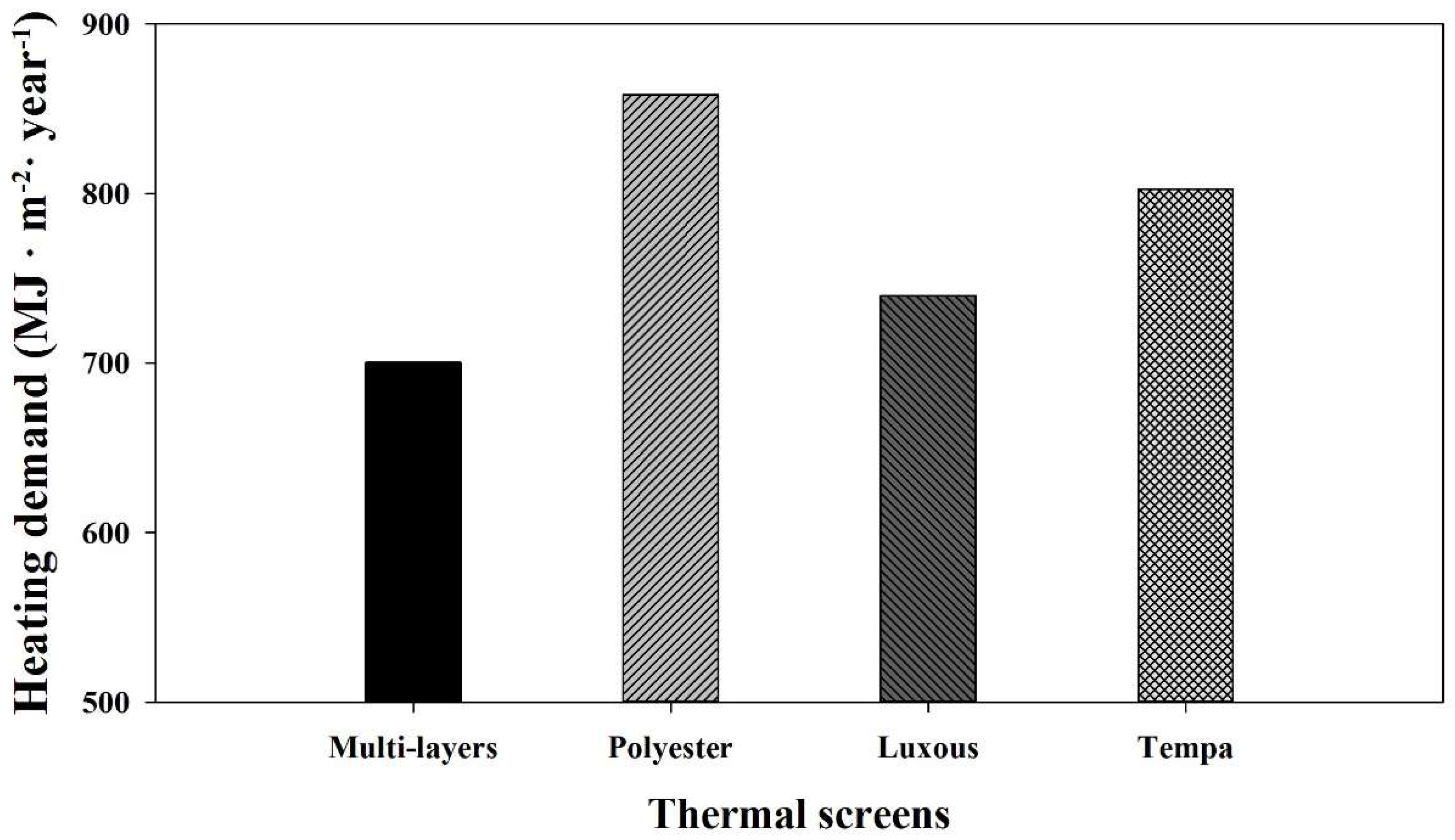
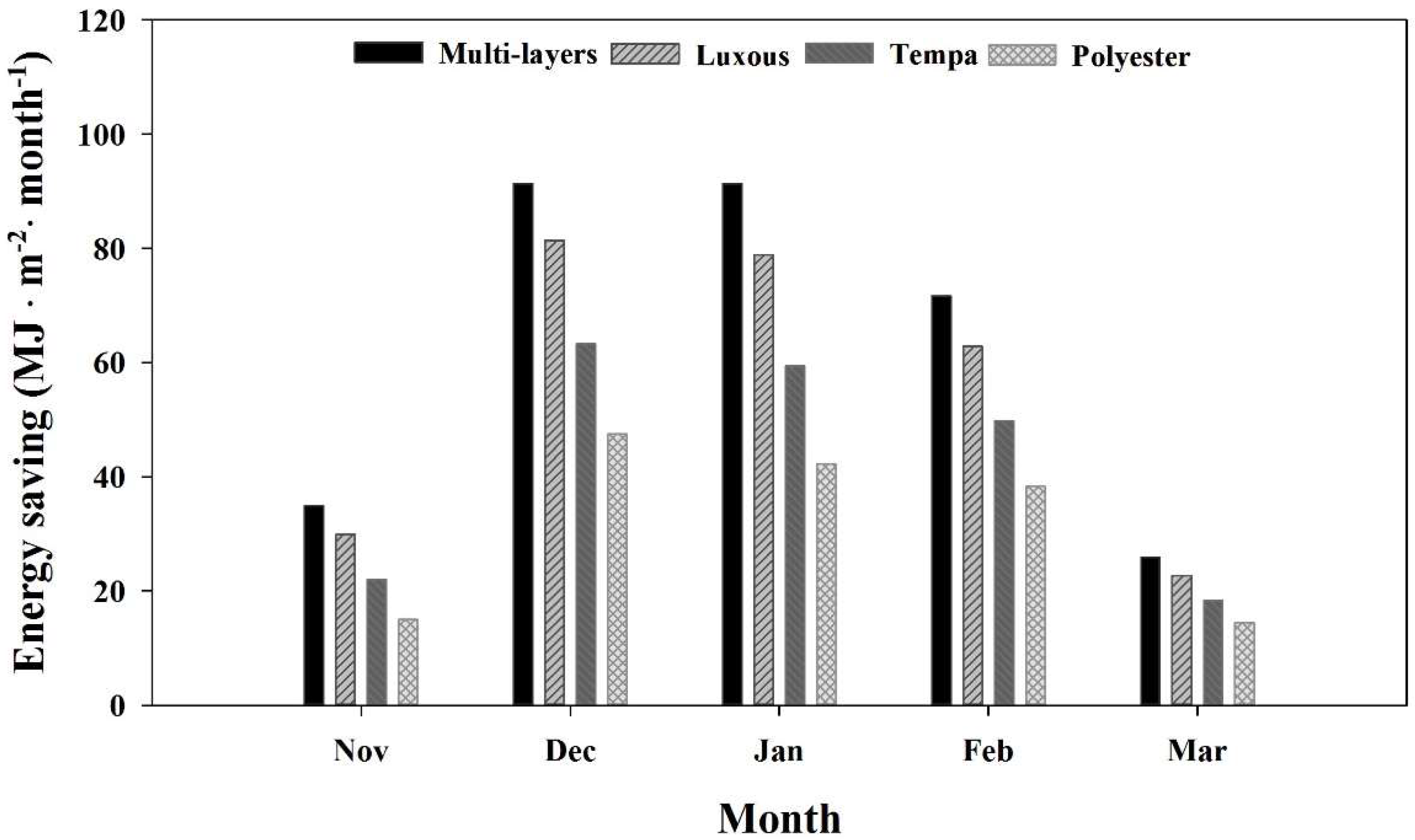
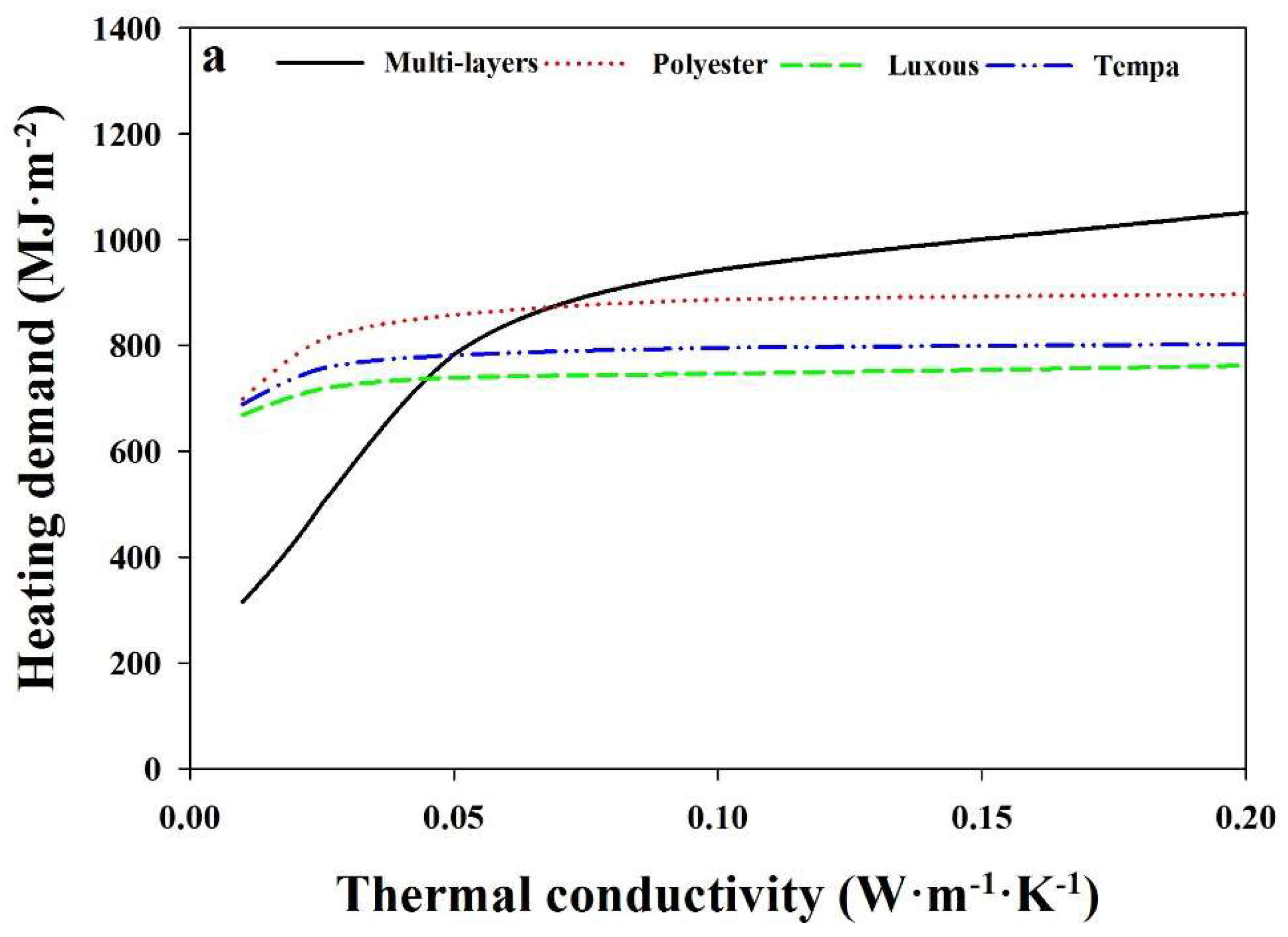
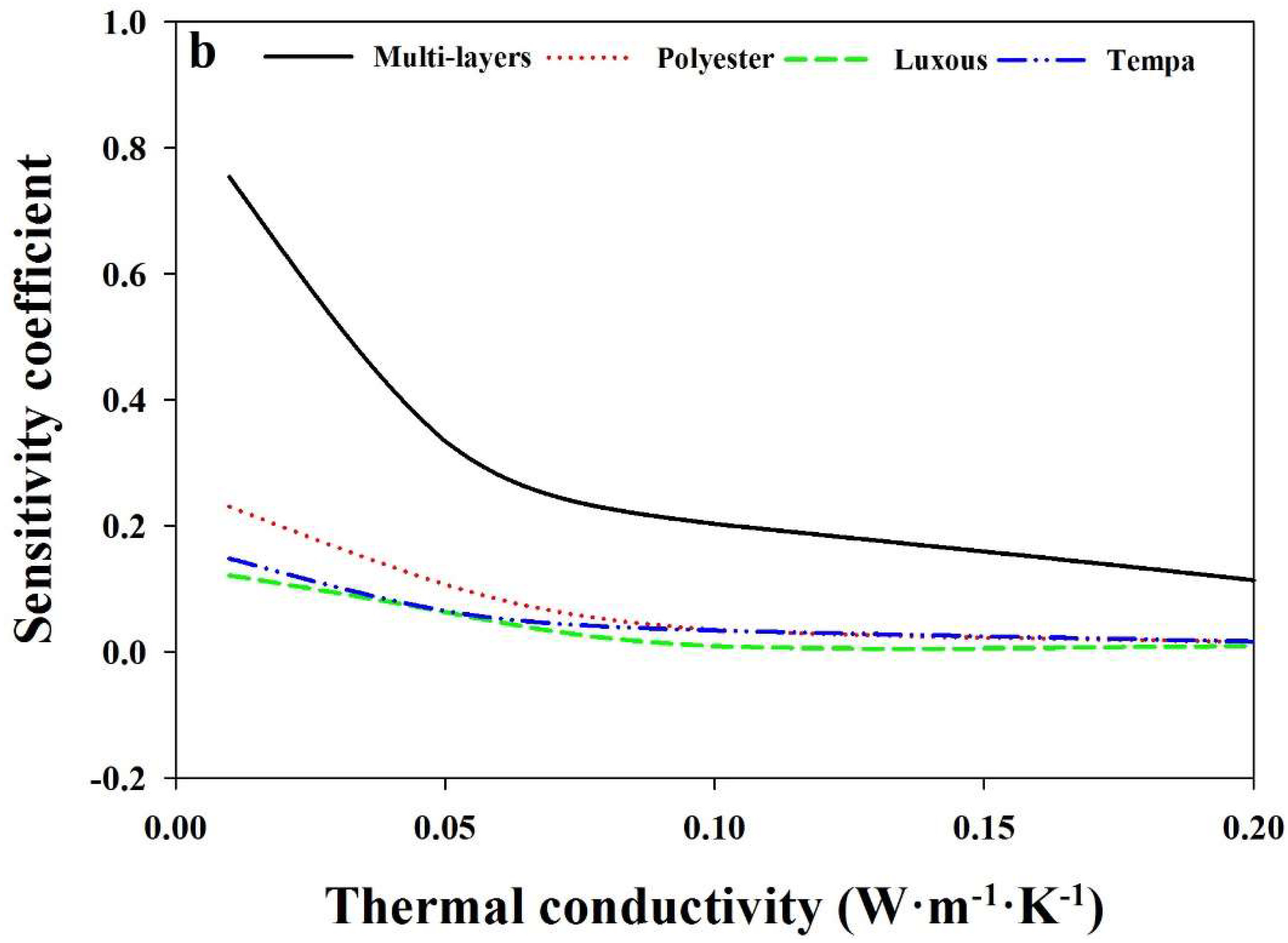

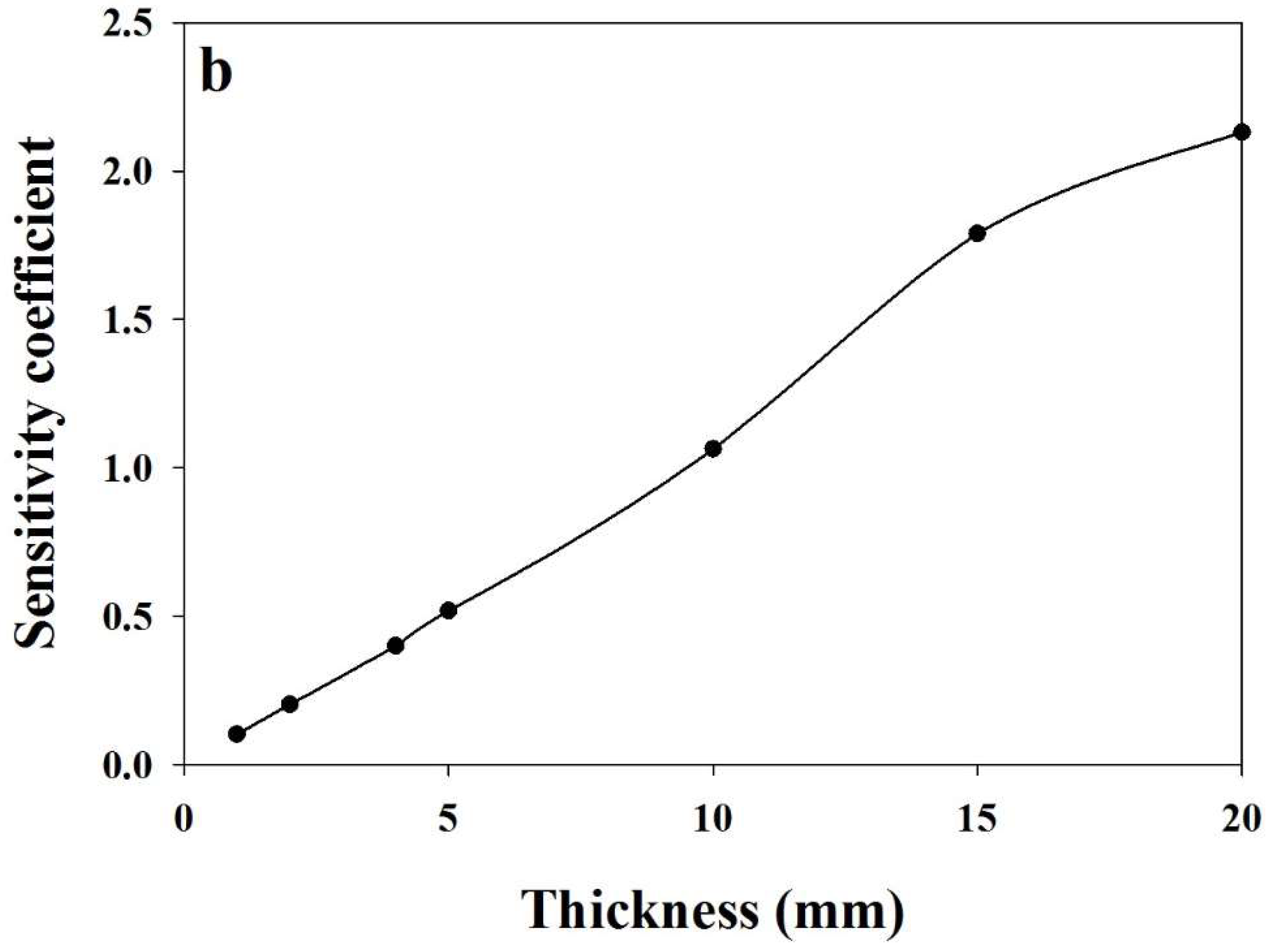
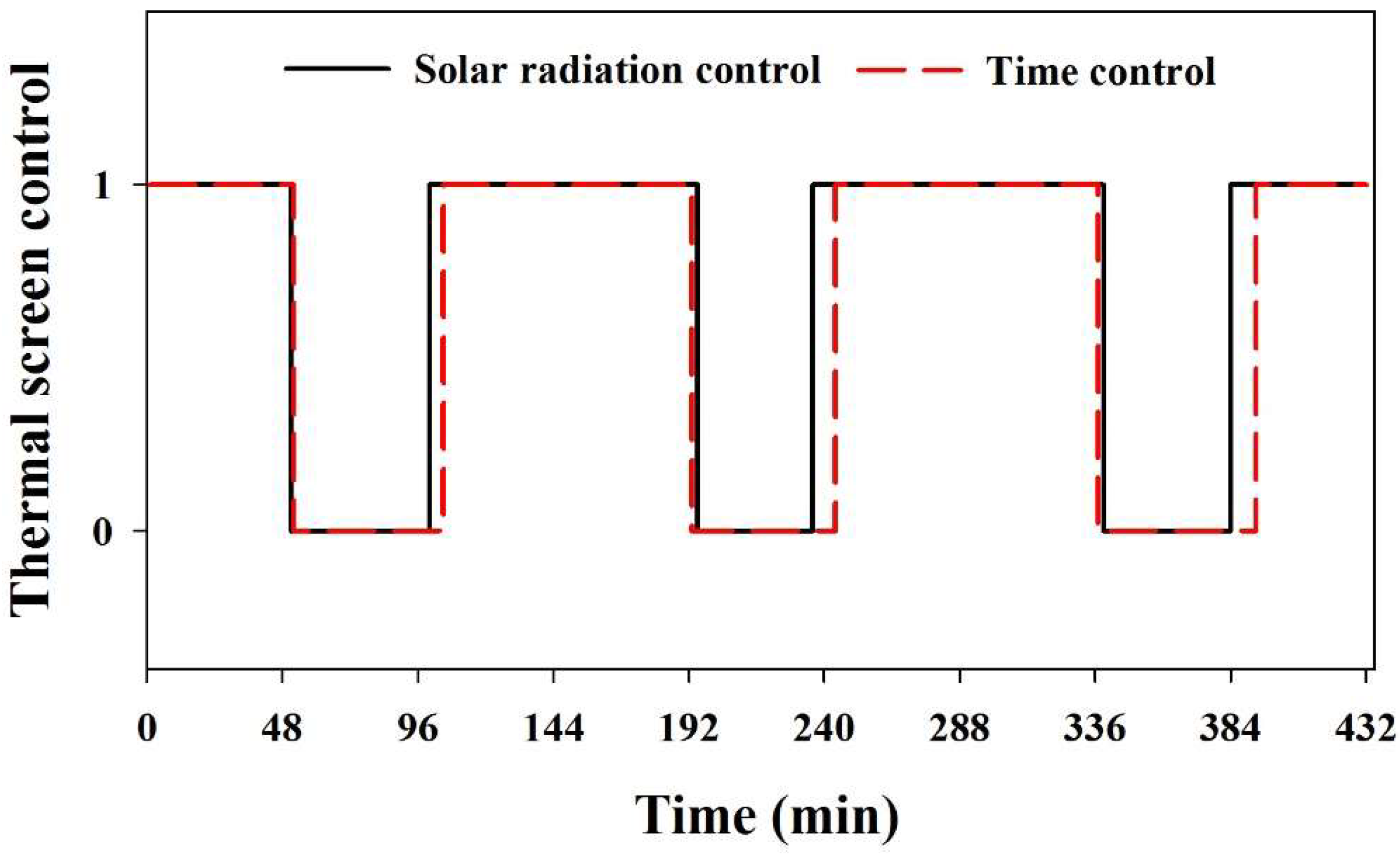

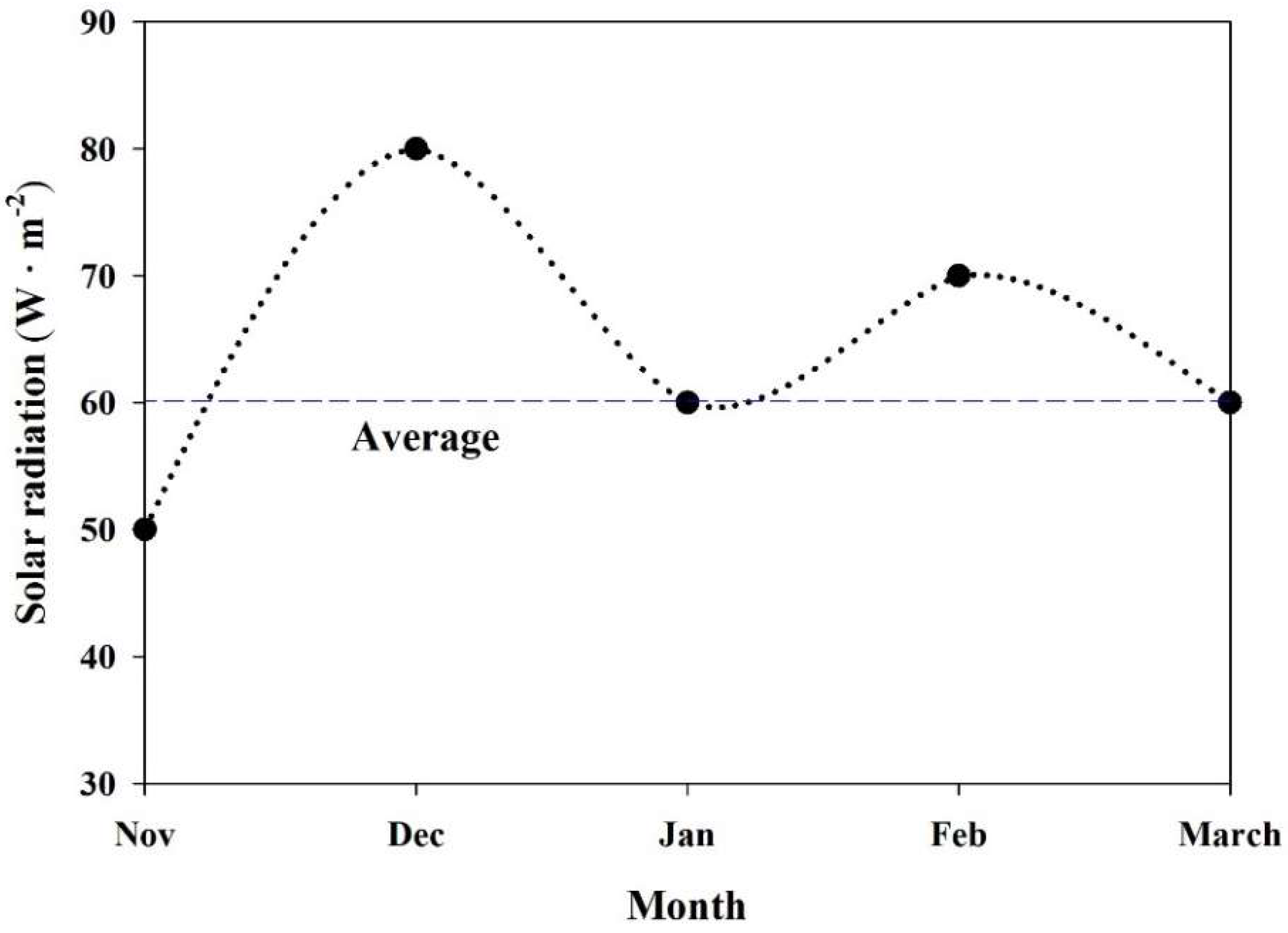
| Weather Parameter | Unit | Time Interval | Sensor | Precision of Sensor | Data Recorded |
|---|---|---|---|---|---|
| Temperature | °C | 10 min | TR-76Ui-H, TECPEL | ±5 °C | Field recorded |
| Relative humidity | % | 10 min | TR-76Ui-H, TECPEL | ±5% | Field recorded |
| Solar radiation | kJ h−1 | 10 min | CMP3, Kipp & Zonen | <5% | Field recorded |
| Wind speed | m s−1 | 10 min | S-WDB-M003, ONSET | ±4% | Field recorded |
| Wind direction | degree | 10 min | S-WDA-M003, ONSET | ±4% | Field recorded |
| Ambient pressure | hPa | 10 min | PTB-220TS, VAISALA | ±0.15 hPa | KMA |
| Feature | Unit | Sensor (PD-11) |
|---|---|---|
| Measuring temperature range | °C | −10 to 200 |
| Minimum sample size | mm3 | 100 × 50 × 20 |
| Measurement range | W·m−1·K−1 | 0.023 to 11.63 |
| Thin sample thickness | mm | 0.03 to 10 |
| Measuring time | Sec | 60 |
| Component | Description |
|---|---|
| TRNBuild | This module used in conjunction with TYPE-56 to input the basic structural description of the greenhouse |
| TRNFlow | This is an add-on to TRNSYS used to design air flow network of natural ventilation of greenhouse |
| Soil noding program | A plugin for Google SketchUp™ program used to create 2D model of greenhouse floor which uses as an input by TYPE-49 |
| Google SketchUp™ | A program used to draw 3D model of greenhouse |
| Trnsys3d | A plugin for Google SketchUp™ program which creat a non-geometric data readable for TRNBuild about greenhouse structural design |
| Berkeley Lab Window 7.4 | This software used to create a DOE-2 file (which is readable by TRNBuild) of the greenhouse covering, and thermal screens using the following known properties of materials: solar transmittance and reflectance, thermal radiation transmittance and emission, visible radiation transmittance and reflectance, conductivity (W·m−1·K−1), and thickness (mm). |
| Screen Types | Thickness (mm) | Conductivity (W·m−1·K−1) | Transmittance (-) | Reflectance (-) | Emittance (-) |
|---|---|---|---|---|---|
| White polyester | 0.4 | 0.0510 | 0.02 | 0.04 | 0.94 |
| Luxous 1347 | 0.22 | 0.0463 | 0.38 | 0.18 | 0.44 |
| Tempa 8672 | 0.25 | 0.2133 | 0.01 | 0.32 | 0.67 |
| Multi-layers | 3.5 | 0.0370 | <0.001 | 0.10 | 0.90 |
| Component | Type | Description |
|---|---|---|
| Weather data reader | 9 | Reads the user-provided weather file |
| Solar radiation processor | 16e | uses the total direct solar radiation on horizontal surface as an input and gives output of total, beam, reflected, and diffuse radiation of tilt surfaces. |
| Sky temperature calculator | 69b | Input: dew point temperature, beam and diffuse radiation on horizontal to calculate sky temperature |
| Psychrometric chart | 33 | Input is dry bulk temperature and humidity ration and calculate dew point temperature |
| Equation editor | This type was used to insert equation. | |
| Greenhouse building model | 56-TRNFlow | This type uses TRNBuild to process greenhouse geometry data and TRNFlow to calculate natural ventilation air flow |
| Ground coupling | 49 | Input for this type is heat transfer from greenhouse to floor and calculates floor temperature |
| Controller | 911 | This type was used to control opening and closing of the side and roof vents for natural ventilation |
| Printer | 25d | This type was used to print results on the external user-provided file |
| Plotter | 65c | This type was used to plot the results in an online plotter |
| Parameter | Operating Condition |
|---|---|
| Roof type | Gambrel |
| Glazing | PE |
| Glazing operation | Single-layer (9:00 AM to 5:00 PM) Double-layer (5:00 PM to 9:00 AM) |
| Orientation | East-West |
| Period | 01-Jan-2018 to 13-Jan-2018 |
| Natural ventilation | Side vents |
| Natural vents control set point temp | 25 °C |
| Thermal Screens | Yes |
| Thermal screens control | Open (8:00 AM), close (5:30 PM) |
| Dimension | 24 m × 7 m × 4 m |
| Floor area | 168 m2 |
| Volume | 532 m3 |
| Heating | 10 °C |
| Parameter | Operating Condition |
|---|---|
| Roof type | Gambrel |
| Glazing | PE |
| Glazing operation | Single-layer (9:00 AM to 5:00 PM) Double-layer (5:00 PM to 9:00 AM) |
| Orientation | East-West |
| Period | 07-Nov-2018 to 12-Nov-2018 |
| Natural ventilation | Side vents |
| Natural vents control set point temp | 23 °C |
| Thermal Screens | Yes |
| Thermal screens control | Open (8:00 AM), close (5:30 PM) |
| Dimension | 24 m × 7 m × 4 m |
| Floor area | 168 m2 |
| Volume | 532 m3 |
| Heating | No |
| Screen | U-Value (W·m−2·K−1) | Thickness (mm) | Conductivity (W·m−1·K−1) | Emissivity (-) |
|---|---|---|---|---|
| Multi-layers | 700.3 | 3.5 | 0.0370 | 0.900 |
| Luxous | 739.8 | 0.22 | 0.0463 | 0.440 |
| Tempa | 802.7 | 0.25 | 0.2133 | 0.670 |
| Polyester | 858.1 | 0.40 | 0.0510 | 0.940 |
| Value | Screen Closed (hours) | Energy Consumption (MJ·m−2) |
|---|---|---|
| Without thermal screens | ||
| 0 | 1015.6 | |
| Time control | ||
| 8:00 AM – 5:30 PM | 2100 | 705.5 |
| Outside global radiation | ||
| 1 (W·m−2) | 2063.5 | 707.3 |
| 10 (W·m−2) | 2098.8 | 705.7 |
| 20 (W·m−2) | 2145.8 | 704.1 |
| 30 (W·m−2) | 2192.7 | 702.4 |
| 40 (W·m−2) | 2233.2 | 701.3 |
| 50 (W·m−2) | 2273.3 | 700.5 |
| 60 (W·m−2) | 2307.3 | 700.3 |
| 70 (W·m−2) | 2340.8 | 700.3 |
| 80 (W·m−2) | 2372.2 | 700.9 |
| 90 (W·m−2) | 2403.2 | 701.8 |
| 100 (W·m−2) | 2432.2 | 702.5 |
| 110 (W·m−2) | 2462.2 | 703.7 |
| 120 (W·m−2) | 2488.2 | 704.9 |
| Outside global radiation and temperature | ||
| 60 (W·m−2)/−20 °C | 2332.7 | 700.3 |
| 60 (W·m−2)/−15 °C | 2332.7 | 700.3 |
| 60 (W·m−2)/−10 °C | 2346.0 | 700.5 |
| 60 (W·m−2)/−5 °C | 2391.7 | 707.6 |
| 60 (W·m−2)/0 °C | 2555.7 | 734.7 |
© 2019 by the authors. Licensee MDPI, Basel, Switzerland. This article is an open access article distributed under the terms and conditions of the Creative Commons Attribution (CC BY) license (http://creativecommons.org/licenses/by/4.0/).
Share and Cite
Rasheed, A.; Na, W.H.; Lee, J.W.; Kim, H.T.; Lee, H.W. Optimization of Greenhouse Thermal Screens for Maximized Energy Conservation. Energies 2019, 12, 3592. https://doi.org/10.3390/en12193592
Rasheed A, Na WH, Lee JW, Kim HT, Lee HW. Optimization of Greenhouse Thermal Screens for Maximized Energy Conservation. Energies. 2019; 12(19):3592. https://doi.org/10.3390/en12193592
Chicago/Turabian StyleRasheed, Adnan, Wook Ho Na, Jong Won Lee, Hyeon Tae Kim, and Hyun Woo Lee. 2019. "Optimization of Greenhouse Thermal Screens for Maximized Energy Conservation" Energies 12, no. 19: 3592. https://doi.org/10.3390/en12193592






